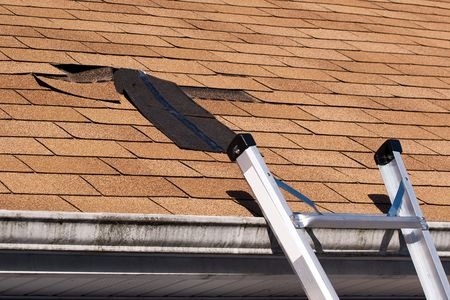If you either suspect or have confirmed that you have leaks in your roof, it is essential that you have those repairs addressed as quickly as possible. Visual evidence of a leak may actually just be an indication of a much more serious issue, and if you let it go too long, you may find that you need to pay for much more extensive (and costly) repairs as a result.
Contact Jackson Contracting Inc. today to speak with a roof leak repair contractor in Indianapolis to learn about your options to solve these issues before they become major problems. We will perform an initial inspection where we will explore every part of your roof and determine every problem spot. A leaky roof can cause major issues in your home that go far beyond the damage to your drywall and paint.
How To Tell If You Have a Leaky Roof
Visual Damage
If you have visual water damage in a wall or ceiling of your home, then this is obviously the most simple way to determine that you have a leak. However, even if you have confirmed that there is a leak, you can not determine exactly where the leak is coming from, or if it is the only leak, without a closer inspection.
The clearest indications of a leak are the dark water stains commonly associated with water damage, as well as bubbling and peeling of plaster, paint, or wallpaper. In addition, you may find that there is water dripping from ceiling fixtures that also indicates an acute leak. Unfortunately, you can’t always rely on visual cues to confirm a leak.
Hearing a Leak
You may also notice dripping sounds in your walls during rain events, even if you do not see water damage. This could happen if you have a heavy leak in your roof, but the water is pooling along the exterior wall, and therefore under your outside shingles. It’s important that you have your roof inspected at the first sound of dripping, since this problem can go on for quite some time before you get visual confirmation.
Pooling In Your Gutters
If your gutters are clogged or drain slowly, it may cause water to back up and soak into your walls or the seams of your shingles even if you do not see any immediate or catastrophic leaks. This pooling water can cause rot, and may even encourage more vegetation to grow, further clogging your drains.
Ways to confirm that your gutters are clogged are to either get on a ladder and visually inspect them (it is recommended that you clean your gutters yearly), or, during high rain, to see if you have water spilling over the edges of the gutters, or if they are draining as expected through the downspouts.
Cracked, Missing, or Worn Roofing Elements
If you notice on the outside of your house that you are missing shingles, have folded or cracked flashing along seams, or see that there is damage to any vents, this may be a symptom of a larger issue. In addition, bubbling, sagging, or discoloration of your roof shingles may be the result of water seepage, leaking, and overall compromising of the weatherproof seal.
What To Do If You Suspect a Leak In Your Roof
If you suspect, even a bit, that you have a leak in your roof, the best thing that you can do is to contact a professional to do an inspection. If the inspection shows that there is no issue, then it is money well spent on peace of mind. If it DOES find leaks, then the inspection will ultimately save you a lot of money in bigger repairs, and even add years to the overall lifespan of your roof.
It is important that you act quickly when you suspect a leak. Slow leaks can cause other issues like black mold, which can be extremely hazardous to your health. In addition to mold, which causes physical issues, the leaks may also cause rot or other structural issues that will impact other parts of your house, not just the roof. The most appropriate response, as soon as you suspect that you have a leak or some other issue with your roof, is to contact a licensed professional immediately and get a comprehensive inspection.

